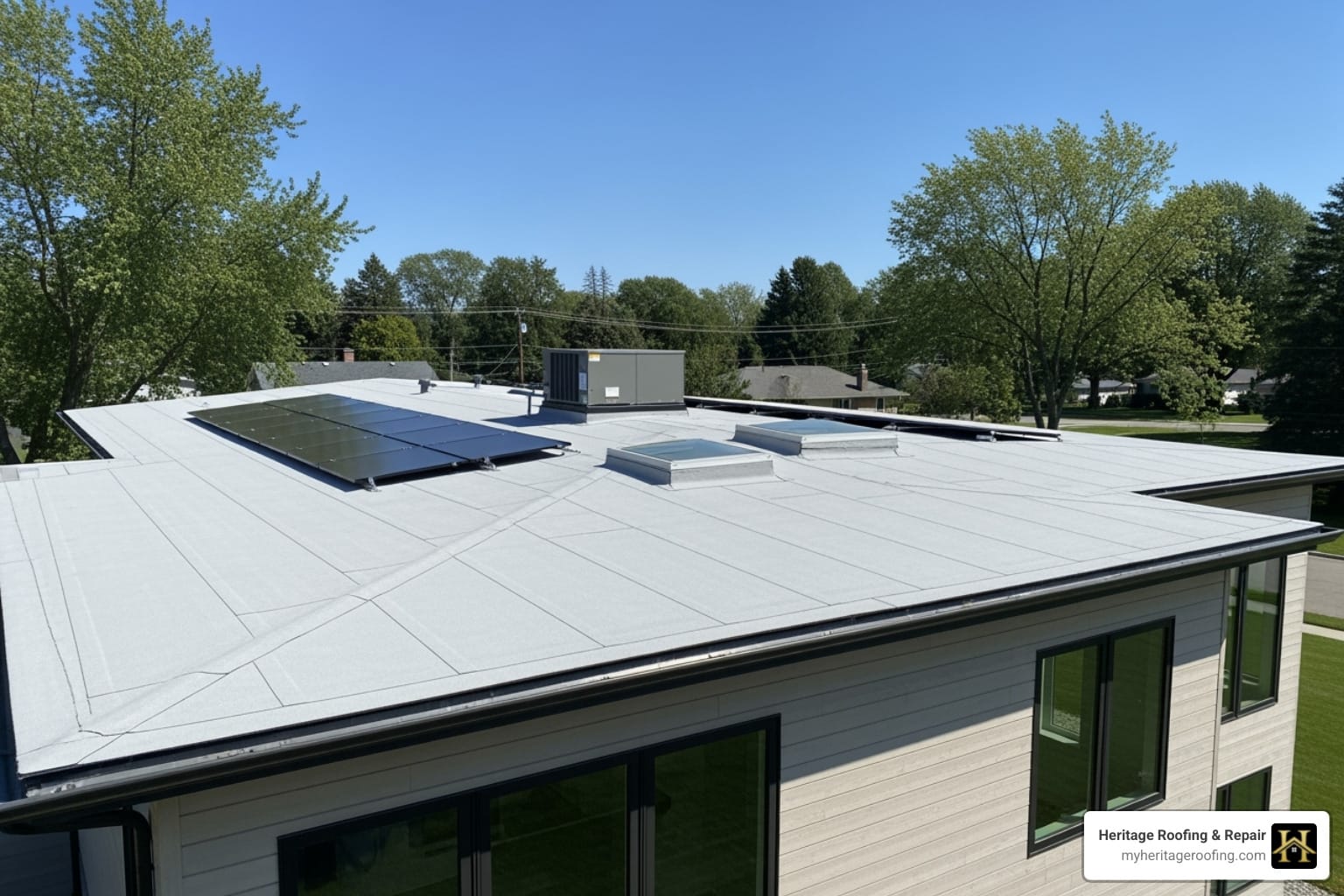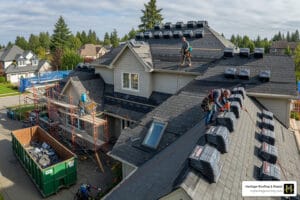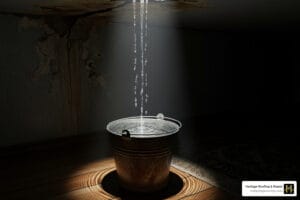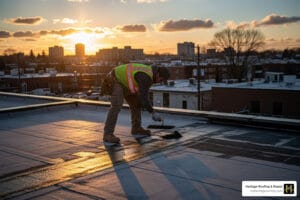The Homeowner’s Guide to Flat Roof Replacement
When your flat roof shows signs of aging, persistent leaks, or significant damage, a residential flat roof replacement becomes a critical investment. For homeowners in Northwest Arkansas, understanding when to act is key to protecting your property from serious structural issues. As a leading roofing company in Berryville, AR, Heritage Roofing & Repair has seen how a failing flat roof can lead to costly problems. This guide provides the essential information you need.
Key Signs You Need a Replacement:
- Age over 20-25 years
- Frequent leaks and water damage
- Visible cracks, blistering, or membrane deterioration
- Pooling water that doesn’t drain
- Rising energy bills from poor insulation
Common Replacement Materials & Costs:
- EPDM: 10-30 years, $6-$10/sq ft
- TPO: 15-30 years, $7-$11/sq ft
- Modified Bitumen: 10-20 years, $8-$12/sq ft
- Built-Up Roofing (BUR): 20-30 years, $12-$19/sq ft
Unlike pitched roofs, flat roofs depend entirely on their membrane and drainage systems. When these fail, water pooling and leaks can cause severe damage. A successful roof replacement hinges on choosing the right material and ensuring professional installation. With over 50 years of family-owned experience, we specialize in modern flat roofing solutions that stand the test of time.
5 Telltale Signs Your Flat Roof Needs Replacing
Your flat roof has a lifespan, typically 20-25 years. Ignoring warning signs can lead to costly structural damage, mold, and poor energy efficiency. Here are five key indicators that your residential flat roof needs professional attention.
1. Frequent Leaks and Water Damage
This is the most alarming sign. Water spots on ceilings, peeling paint, or musty odors indicate a compromised roof. While a single leak might be patchable, frequent issues suggest the entire system is failing. After severe weather, damage like rips, punctures, or seam separations often requires professional intervention to prevent further harm.
2. Significant Surface Damage
Inspect your roof’s surface for cracks, blisters, or splits. Cracks, or “alligatoring,” show the material is drying out. Blisters and bubbles point to trapped moisture, signaling the end of the roof’s functional life. Punctures and seam separations are direct entry points for water. You can explore what these issues look like on different roofing materials.
3. Ponding Water That Won’t Evaporate
Flat roofs have a slight slope to direct water to drains. If water stands for more than 48 hours after rain, you have a “ponding” problem. This can be caused by a poor slope, clogged drains, or a sagging roof deck. The excess weight stresses the structure and accelerates material decay, increasing leak risks.
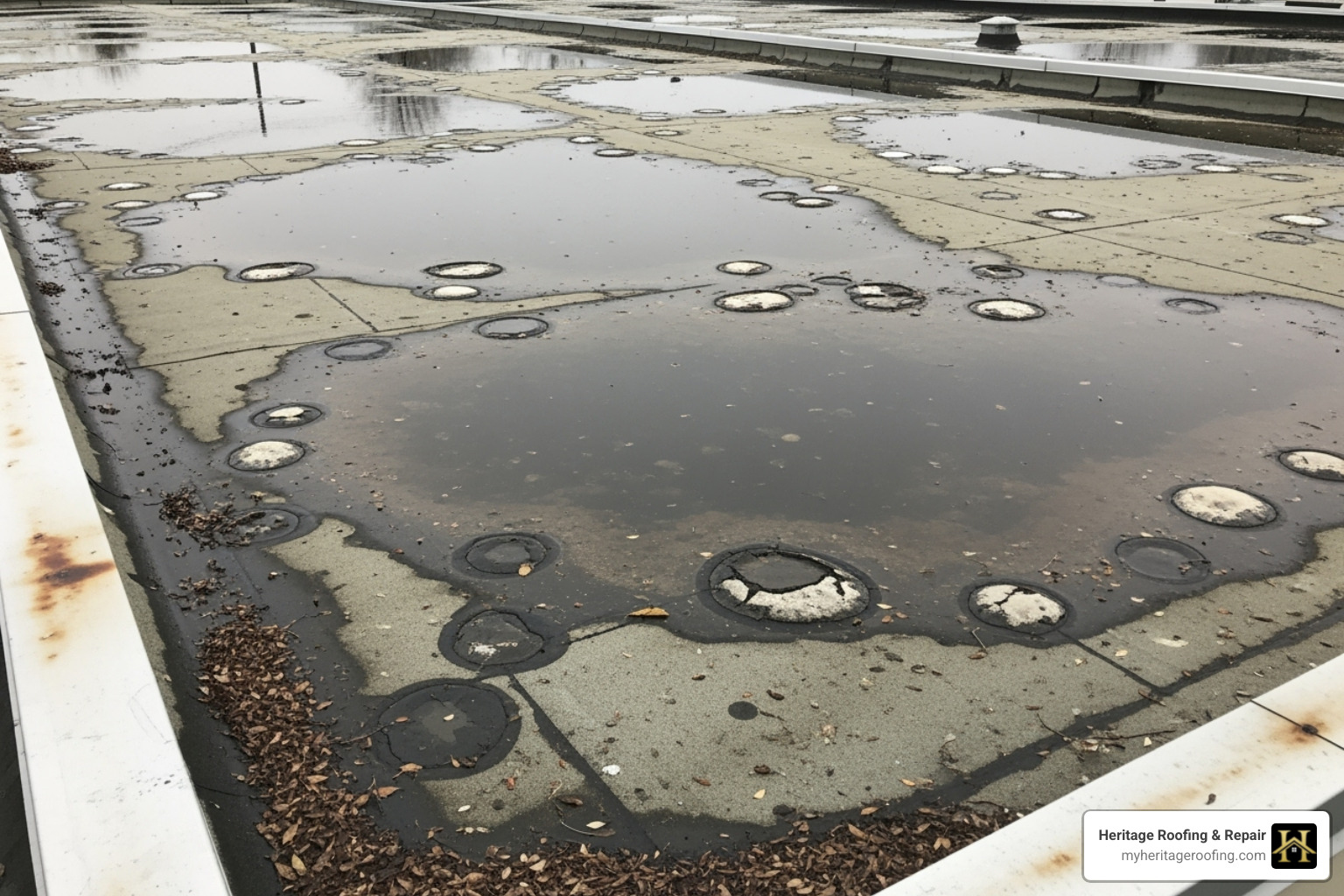
4. Rising Energy Bills
A sudden spike in heating or cooling costs can indicate a failing roof. When the membrane deteriorates, moisture can seep into the insulation, reducing its effectiveness. Your HVAC system works harder to compensate, driving up energy bills. A residential flat roof replacement can be a smart long-term financial decision.
5. Age of the Roof
Even if it looks fine, age is a critical factor. Most flat roofs are designed to last 20-25 years. As materials degrade, the roof becomes more vulnerable to failure, especially during severe weather. If your roof is approaching or past this age, it’s wise to have its condition professionally assessed to see if a replacement is on the horizon.
Flat Roofing Materials 101: Comparing Your Options
Choosing the right material is crucial for the longevity and performance of your residential flat roof replacement. Your decision impacts cost, durability, and energy efficiency. Modern materials make flat roofs a viable, long-lasting option for homes.
Single-Ply Membranes (TPO, PVC, EPDM)
These single-layer membranes are popular for their quick application and excellent watertight performance.
- TPO (Thermoplastic Polyolefin): Known for energy efficiency (especially white TPO) and mold resistance. Its heat-welded seams create a very strong, watertight bond. TPO typically lasts 15-30 years.
- PVC (Polyvinyl Chloride): Similar to TPO, PVC is a strong, flexible, and heat-welded material that is highly waterproof and resistant to chemicals.
- EPDM (Ethylene Propylene Diene Monomer): Often called “rubber roofing,” EPDM is durable, cost-effective, and resistant to UV radiation. It’s a trusted material in both commercial and residential markets. Learn more about EPDM Roofing.
Asphalt-Based Roofing (BUR and Modified Bitumen)
These traditional methods have a long history of reliability.
- Built-Up Roofing (BUR): The oldest flat roofing type, using multiple layers of asphalt and reinforcing fabrics topped with gravel. It’s thick and durable but heavy and difficult to repair.
- Modified Bitumen (Mod-bit): A modern version of BUR, asphalt is mixed with polymers for flexibility. It’s a durable option often installed with a torch-down method.
Metal Roofing
While less common for entire flat roofs, metal is an excellent, highly durable option for smaller sections.
- Standing Seam Metal: Panels with interlocking raised seams create a highly weather-resistant surface. Metal roofs offer exceptional durability (50+ years), low maintenance, and energy efficiency, though at a higher upfront cost.
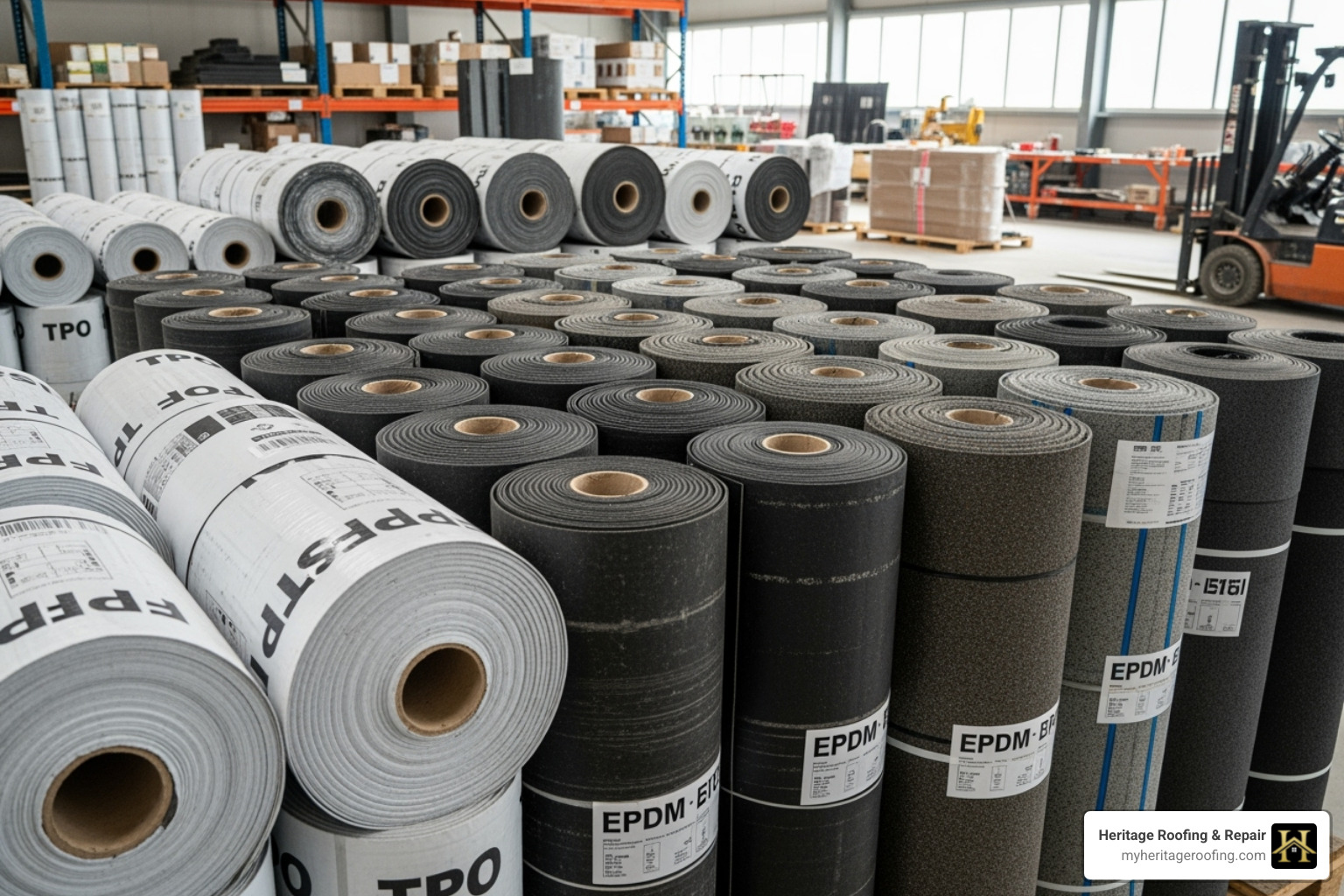
When selecting a material, consider our roofing materials guide for more in-depth information.
| Material | Lifespan (Years) | Cost per Sq. Ft. (Average) | Pros | Cons |
|---|---|---|---|---|
| EPDM (Rubber) | 10-30 | $6-$10 | Durable, cost-effective, resistant to weathering/UV, easy to repair. “The budget-friendly option.” | Can absorb heat (black EPDM), seams may require more attention than heat-welded types. |
| TPO | 15-30 | $7-$11 | Energy-efficient (white reflects heat), strong heat-welded seams, resistant to mold/algae. “The affordable flat roof.” | Newer product, long-term durability still being fully time-tested compared to older materials. |
| PVC | 15-30 | $8-$13 | Extremely durable, chemical resistant, strong heat-welded seams, good for heavy foot traffic. “The happy medium.” | Can be more expensive than EPDM/TPO, may become brittle in extremely cold temperatures. |
| Modified Bitumen | 10-20 | $8-$12 | Flexible, good for temperature extremes, easier to install than BUR, durable. “The middle of the road option.” | Shorter lifespan than some single-ply, torch-down application requires skilled professionals and safety precautions. |
| Built-Up Roofing (BUR) | 20-30 | $12-$19 | Proven reliability, durable, fire-resistant, affordable. “The priciest flat roof” due to layers. | Heavy, labor-intensive installation, difficult to locate/repair leaks, can crack in extreme cold. |
| Metal | 50+ | $11-$18 | Exceptional longevity, very durable, low maintenance, energy-efficient, recyclable, modern aesthetic. “The flashy option.” | High upfront cost, can be noisy during rain/hail, requires specialized installation. |
The Residential Flat Roof Replacement Process & Cost Factors
A full residential flat roof replacement is a multi-step process. Understanding the steps and cost factors will help you plan effectively. While modern flat roofs are simpler than older, multi-layered ones, the process still requires professional expertise.
The Step-by-Step Replacement Process
A typical replacement follows this sequence:
- Inspection and Assessment: A thorough inspection to assess damage and plan the project.
- Old Roof Tear-Off: Complete removal of existing materials to expose the roof deck.
- Deck Repair: The underlying wood deck is inspected and any rotted sections are repaired or replaced.
- Insulation Installation: New, often tapered, insulation boards are installed for energy efficiency and proper drainage.
- New Membrane Installation: The chosen material (TPO, EPDM, etc.) is installed and all seams are sealed.
- Flashing and Sealing: Vents, pipes, and edges are flashed to create a watertight barrier.
- Final Inspection & Cleanup: A final check to ensure compliance with building codes and a thorough cleanup of the site.
For more details, explore our roof replacement services.
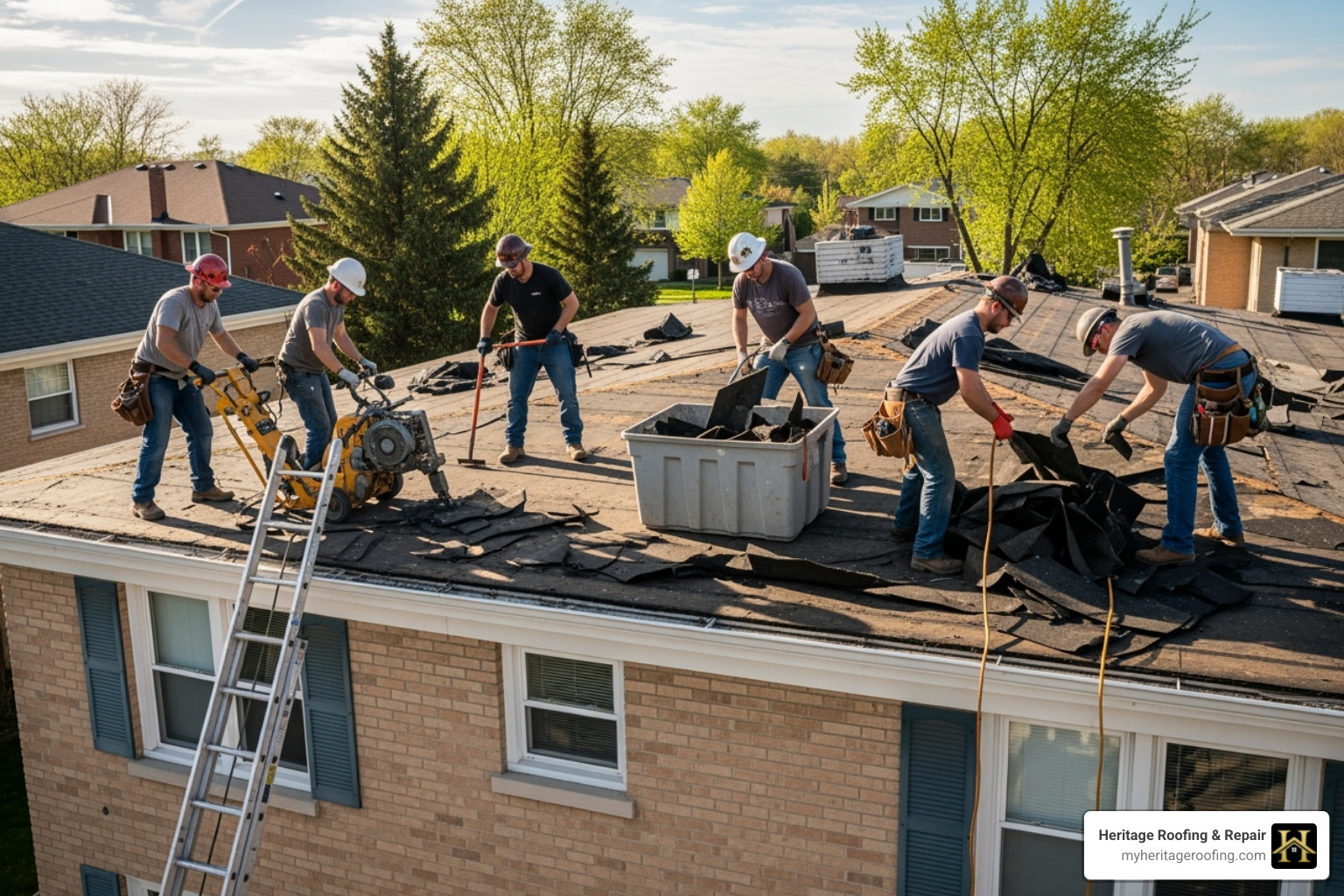
Key Factors Influencing Cost
The cost of a flat roof replacement typically ranges from $3,000 to $20,000, with an average of $6-$9 per square foot. The final price depends on:
- Roof Size and Complexity: Larger or more complex roofs require more materials and labor.
- Material Choice: Costs vary significantly between materials like EPDM and high-end metal.
- Labor Costs: Varies by location and job complexity.
- Roof Accessibility: Difficult access can increase labor costs.
- Deck Condition: Rotted deck repairs will add to the total cost.
- Number of Old Layers: Removing multiple old roof layers is labor-intensive.
- Permits and Upgrades: Permit fees and insulation or drainage upgrades also affect the price.
We understand a new roof is a significant investment and offer roofing financing options to help.
Why Professional Replacement is Non-Negotiable
A full replacement is not a DIY project. Professionals are essential for:
- Watertight Installation: Flat roofs are unforgiving. Experts have the tools and training to ensure proper sealing.
- Building Code Compliance: Pros ensure your new roof meets all local safety and construction standards.
- Safety: Roofing is dangerous. Professionals use proper safety gear and protocols.
- Warranty Validation: Manufacturer warranties typically require professional installation.
- Longevity: A professionally installed roof lasts longer and performs better, saving you money in the long run. Poor installation is a leading cause of flat roof failure. Learn more about DIY vs Professional Roofing.
Hiring the Right Pro for Your Flat Roof Project in Berryville, AR
Choosing a qualified contractor is the most critical decision for your residential flat roof replacement. Look for a local, experienced team with a proven track record in flat roofing systems.
- Licensing and Insurance: Verify the contractor is fully licensed and insured to protect yourself from liability.
- Local Experience: A local roofer understands regional building codes and climate challenges. Our team has served Northwest Arkansas, including as the trusted roofers in Berryville, AR, for over 50 years.
- Positive Reviews: Check online reviews and ask for references. A strong reputation indicates reliability.
- Detailed Estimates: Get a clear, itemized quote. Be wary of vague or unusually low bids.
- Warranty Information: Understand both material and workmanship warranties. Learn more about roofing warranty specifics.
- Clear Communication: Choose a contractor who answers your questions and keeps you informed.
Your Local Flat Roofing Experts
For homeowners in Northwest Arkansas, finding a trusted local roofer is essential. We pride ourselves on dependable, affordable, and quality craftsmanship.
Heritage Roofing & Repair
3458 Arkansas State Hwy 221, Berryville, AR 72616
(870) 654-1164
Protecting Your Investment: Essential Flat Roof Maintenance
Once your new residential flat roof replacement is installed, proactive care is vital to maximize its lifespan and prevent costly repairs. With proper maintenance, a flat roof can last for decades.
- Regular Inspections: Inspect your roof twice a year (spring and fall) and after severe weather. Look for wear, cracks, blisters, or punctures.
- Debris Removal: Regularly clear leaves, branches, and other debris that can trap moisture and cause damage.
- Drain Cleaning: Ensure all gutters, downspouts, and drains are clear to prevent water from pooling.
- Seam and Flashing Checks: Pay close attention to seams and flashing around vents and chimneys, as these are common failure points.
- Prompt Repairs: Address small issues like punctures or seam separations immediately to prevent them from becoming major leaks.
For more guidance, check out our roofing maintenance tips.
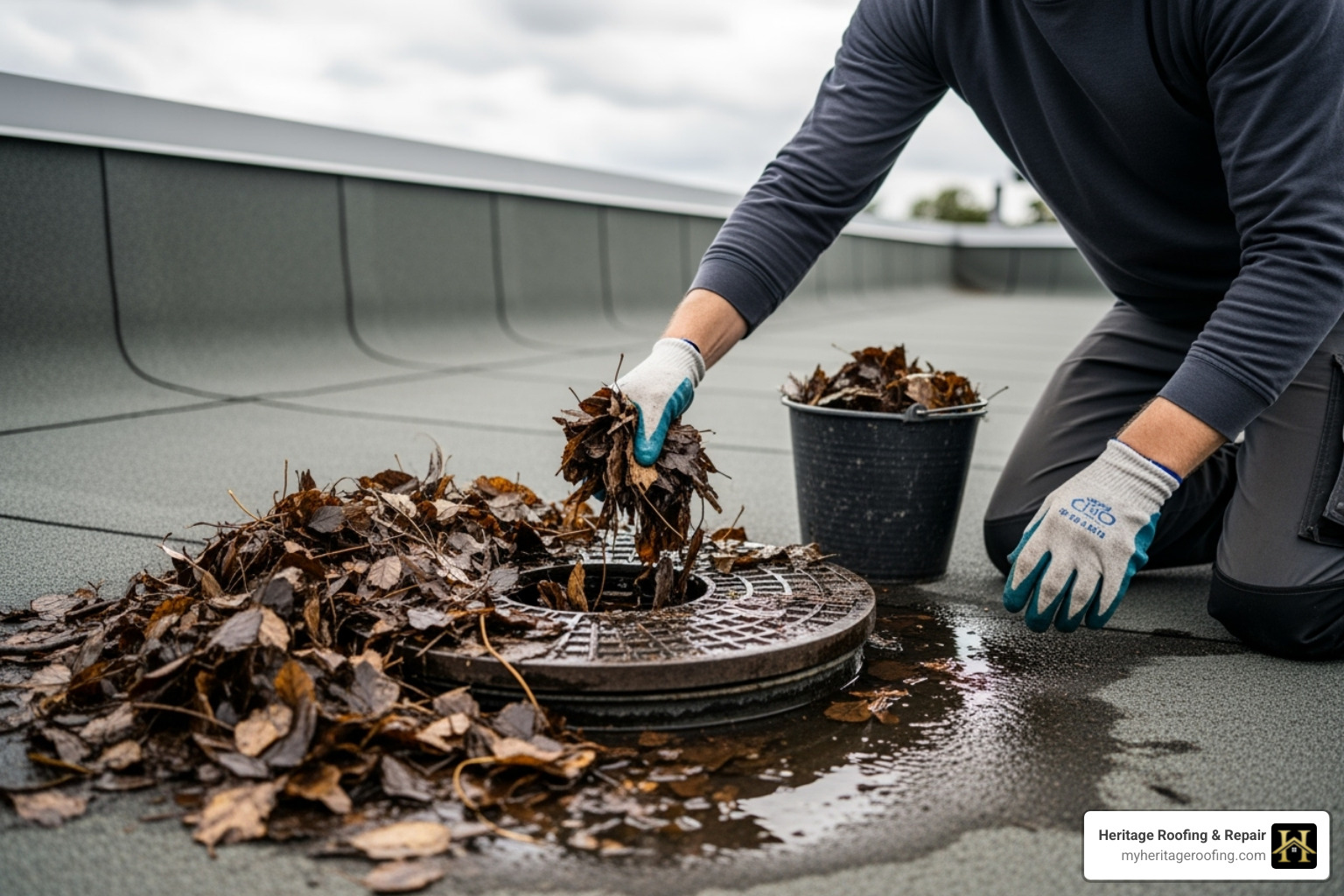
Frequently Asked Questions about Residential Flat Roof Replacement
How long does a flat roof last?
The lifespan varies by material. Modified Bitumen lasts 10-20 years, TPO and PVC last 15-30 years, and EPDM can last 30+ years with proper care. Metal is the most durable, lasting 50+ years.
Can you install a new flat roof over an old one?
A complete tear-off is almost always recommended over an overlay. A tear-off allows for inspection and repair of the underlying roof deck, preventing hidden issues from compromising the new roof. Installing over a damaged base is a recipe for future failure.
Are flat roofs more expensive than pitched roofs?
Per square foot, flat roof materials and installation can be less expensive than for a pitched roof due to simpler framing. However, the total cost depends on the material, size, and complexity. While the initial cost may be lower, they require diligent maintenance to prevent water pooling.
Secure Your Home with a Professional Flat Roof Replacement
A residential flat roof replacement is a vital investment in your home’s safety and value. By recognizing the warning signs, choosing the right materials, and hiring a reputable contractor, you ensure a durable, watertight result. A professionally installed flat roof protects your property and can even offer new utility, like space for a rooftop garden or solar panels.
Don’t wait for a small leak to become a major disaster. If your flat roof shows signs of wear, contact a professional for an inspection. The team at Heritage Roofing & Repair has over 50 years of experience providing quality craftsmanship to homeowners in Berryville, AR, and across Northwest Arkansas.
Ready to discuss your project? Schedule your expert roof replacement consultation today!
